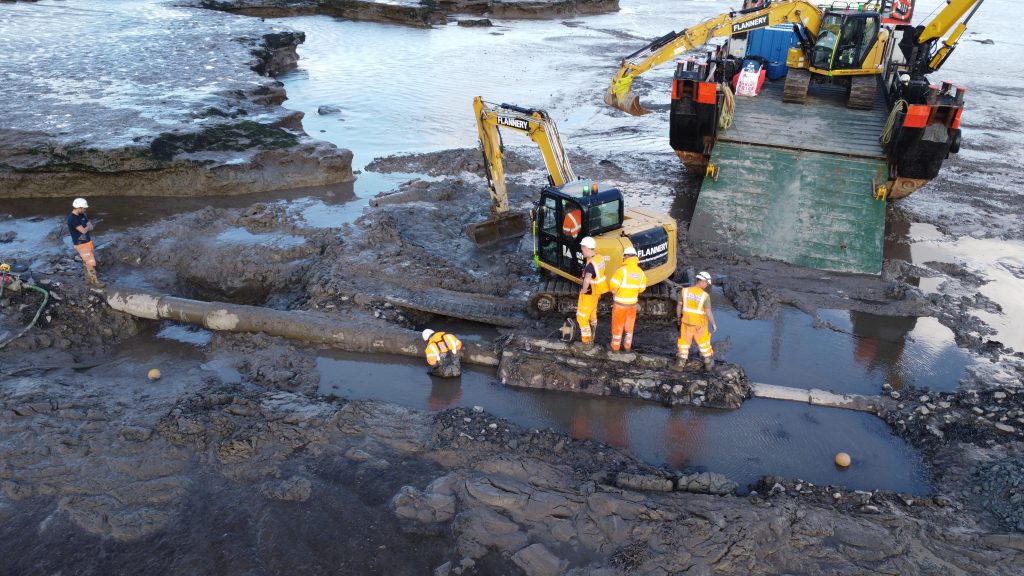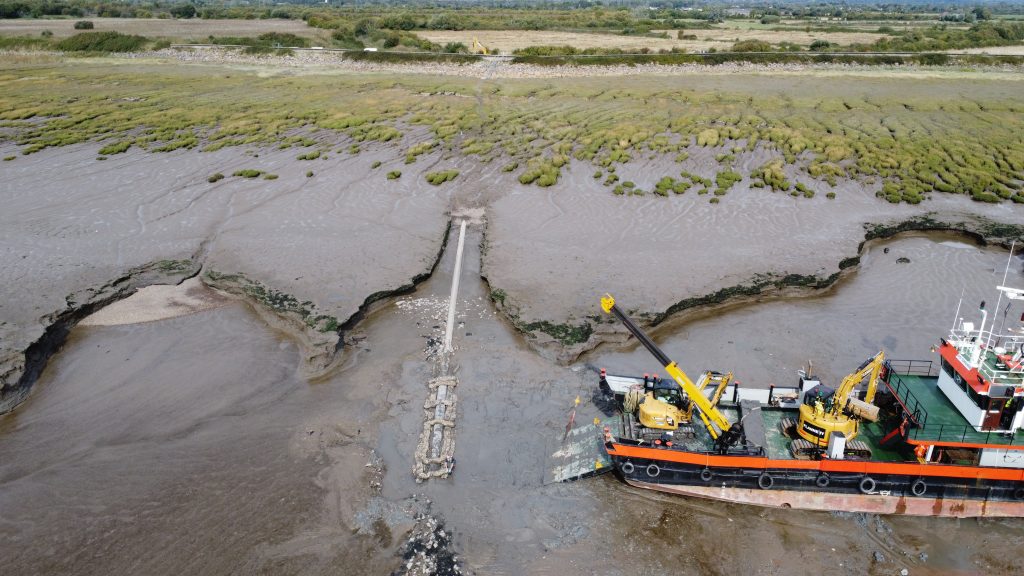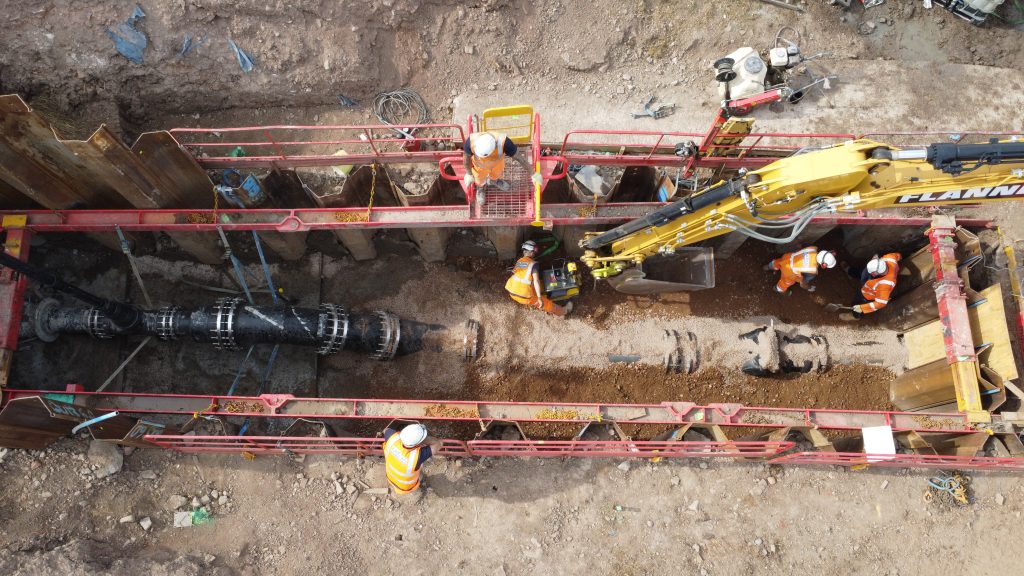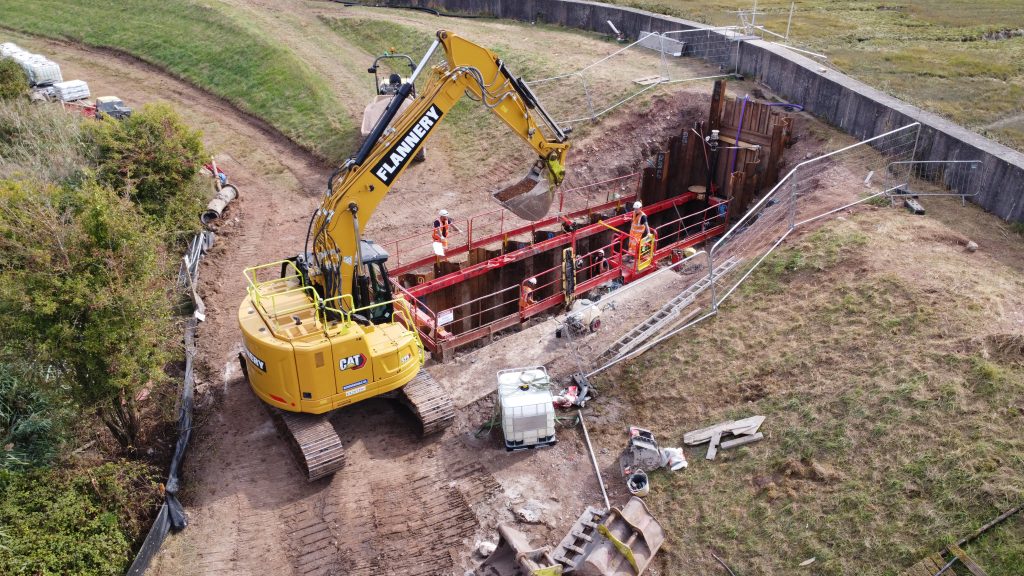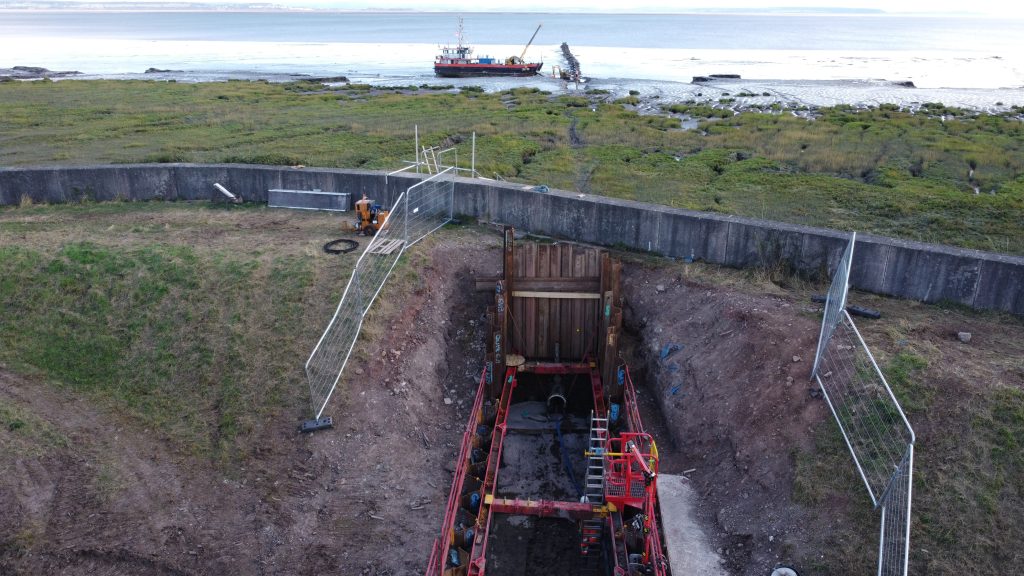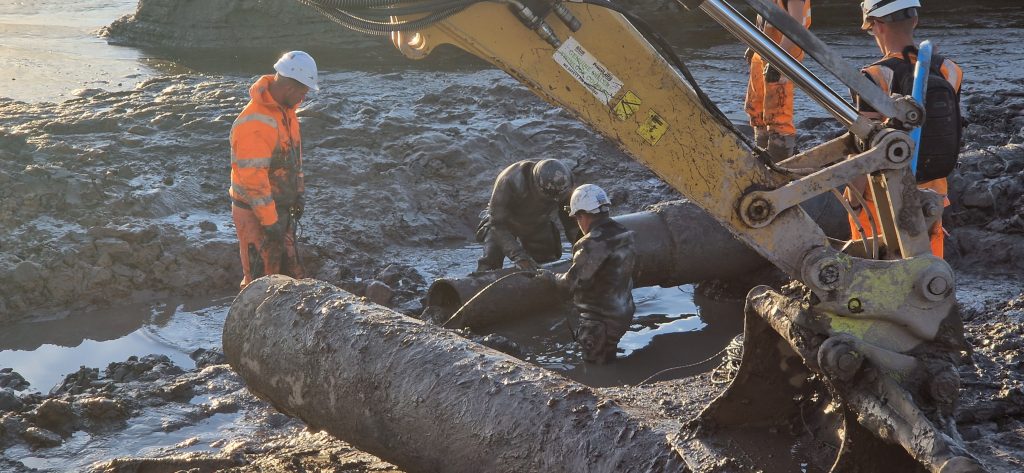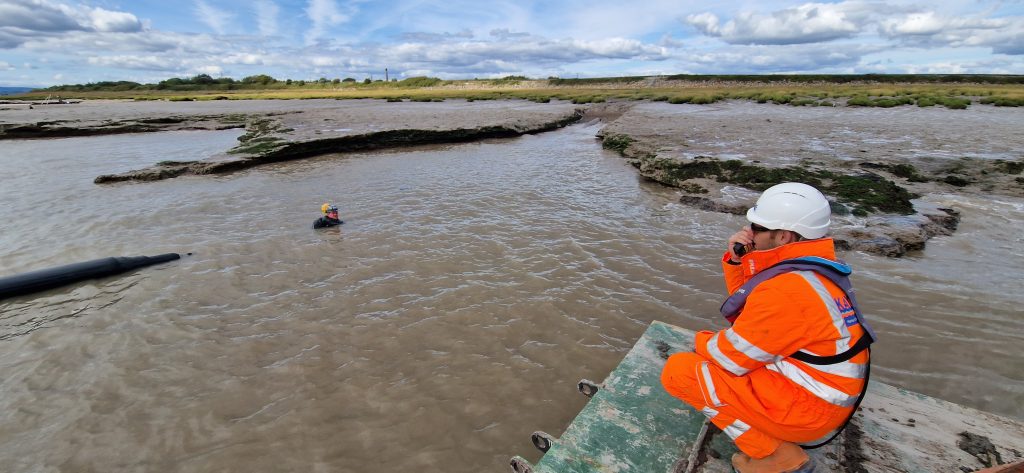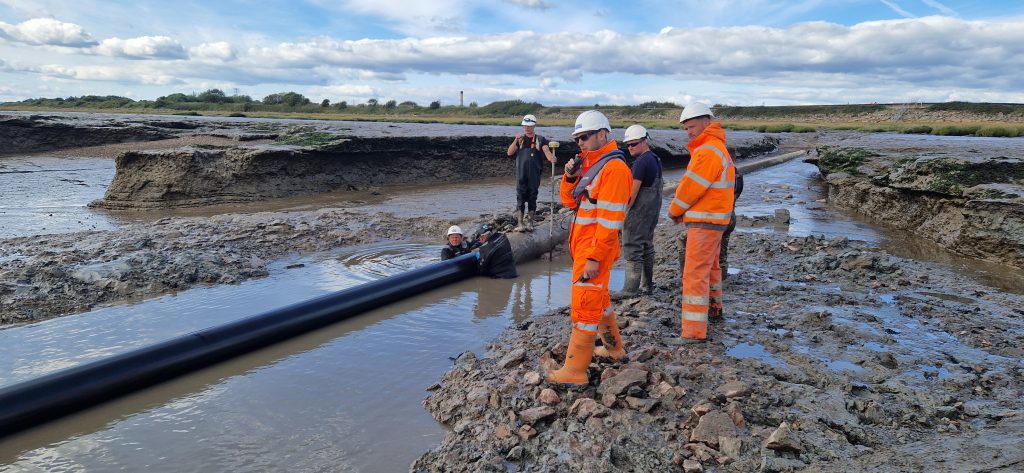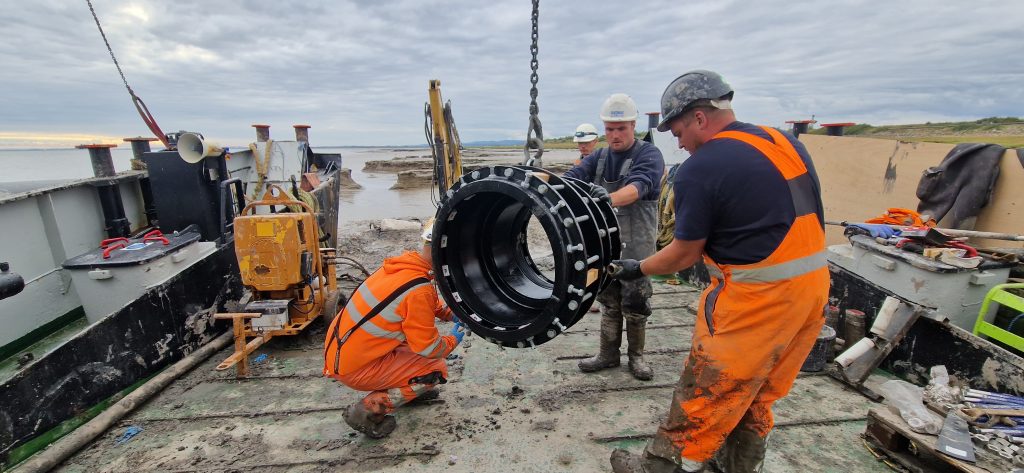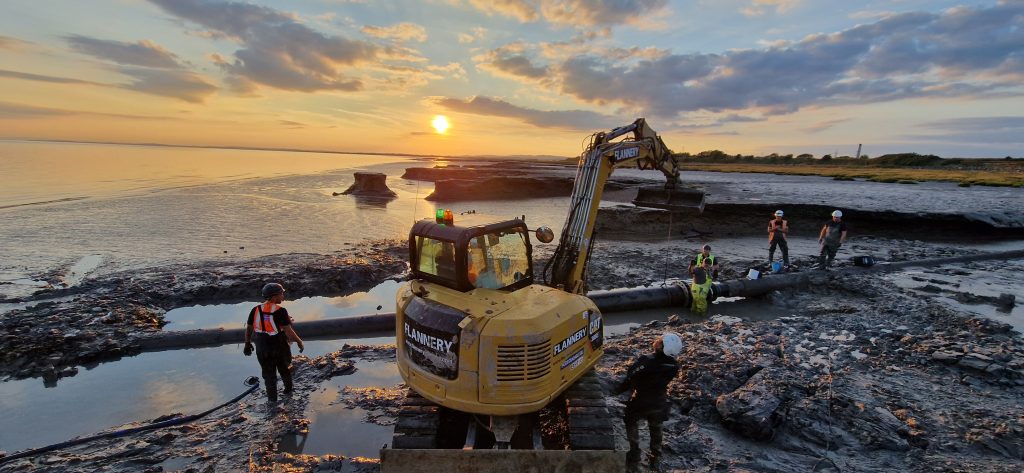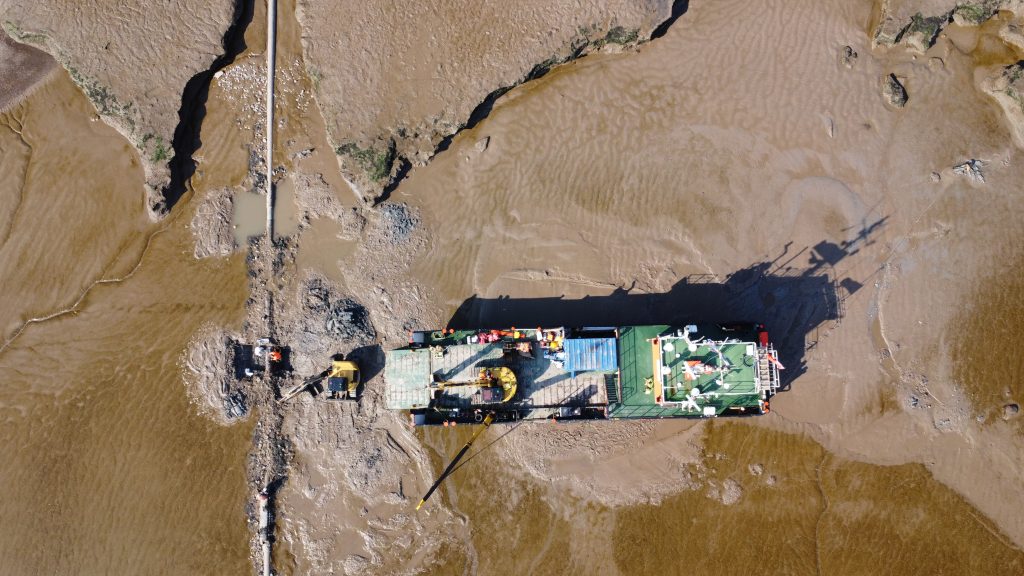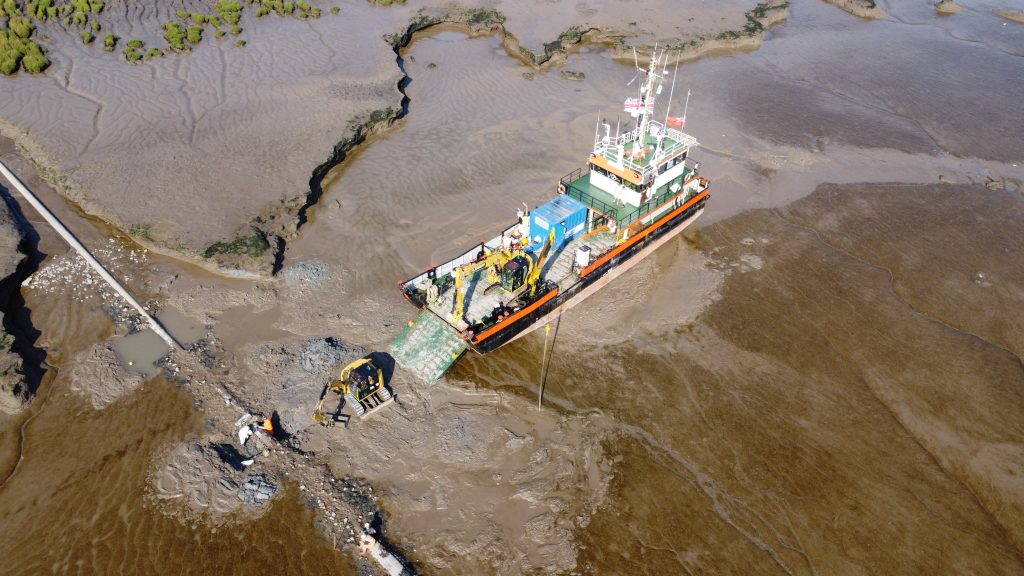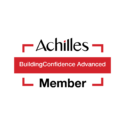Eastman Sea Outfall Slip Lining Project
The outfall was originally constructed in 1960 and is located near Nash in Newport. The offshore section of the outfall consists of a 1470m long concrete coated steel pipe that discharges into the Severn Estuary. The offshore section of pipe, which travels under the sea defence wall and terminates in the low water zone, was nearing the end of its design life and due for replacement.
Kaymac Marine and Civil Engineering Ltd were contracted by the Eastman Chemical Company under ‘Early Contractor Involvement’ (ECI) to undertake the design and installation of the new outfall pipe, which would replace the original pipe. The installation was programmed to take place in accordance with the Newport Council Planning Permission and Natural Resource Wales Band 3 Marine License conditions, both of which Kaymac obtained on behalf of the client.
Pre-Construction Phase
The detailed design considered the physical forces such as currents, waves, and hydrostatic pressure forces; the longevity of the proposed solution, with in-depth considerations given to the specified materials, jointing techniques, stabilisation through concrete ballast collars, intended construction method, and long-term protection of the asset; the internal hydraulics of both the new and existing pipeline, external stress inducing hydrodynamic oceanic forces, structural integrity and stability, material suitability, seabed geomorphology, competing uses of the ocean area, and design checks on the installation methodologies.
The planning, detailed design, and construction stages were closely linked and were collectively considered to ensure that an economical and efficient solution was provided. These stages were managed by Kaymac’s experienced in-house engineers, taking due consideration of the practicality and feasibility of the proposed construction methods; the team responsible for the planning and design were also responsible for the construction stage, ensuring works continuity.
Kaymac utilised their in-house expertise to obtain the required environmental licenses for the Client, and organised a series of investigative surveys which would ensure the design parameters were substantiated with geophysical and bathymetric information. Information obtained assisted in the early identification of any potential obstructions or problem areas and provided an opportunity to obtain further site information to facilitate the detailed design. To ensure the quality of the proposed materials were of a high quality and the works could be undertaken within the licensing timeframes, Kaymac engaged early with suppliers to guarantee the supply of materials and undertook inspections of the manufacturing and quality control processes.
Prior to the main construction works commencing, Kaymac mobilised to site and undertook a series of investigative works:
North of the Sea Wall
The works undertaken in this location was inclusive of a 3D topographical survey and GI works in the form of boreholes.
South of the Sea Wall
The works undertaken here included the completion of the topographical survey, bathymetric survey, and a geophysical survey, together with GI investigative works in the form of boreholes and trial pits. An internal CCTV survey of the existing pipeline was also undertaken. On completion of these surveys, Kaymac demobilised from site and commenced the detailed design stage for the replacement of a 150m length of the pipe which ran beneath the environmentally sensitive salt marsh.
Following the investigative surveys, Kaymac commenced the optioneering stage using the latest 3D modelling technology to visualise the project and identify potential risks, with two potential options suggested by Kaymac.
Option A: To excavate down to the existing pipe north of the sea wall, construct a sheet piled cofferdam around the existing pipe valves, and install a Y-branch to the existing pipe during a short shutdown period. This Y-branch would enable the full new length of pipe to be installed without the requirement of shutting down the Clients plant for an extended period. The sea defence wall and embankment would be excavated to enable the new section of pipe to be installed, with a temporary flood gate installed and used during non-working hours to maintain the flood protection provided by the sea defence wall. A trench would then be excavated to accommodate the new 500mm diameter pipe adjacent to the existing. The new pipe would then be connected to the new Y-branch section with marine grade fixings.
Option B: To excavate down to the existing pipe north of the sea wall and construct a sheet piled cofferdam around the existing pipe valves. On the offshore section, a 10m section of the existing pipe would be removed to enable access for the new HDPE to be slip-lined through; a technique used for repairing leaks or restoring structural stability to an existing pipeline. It would involve installing a smaller, carrier pipe into a larger host pipe and sealing the ends. Our method was to import a 150m length of 355mm external diameter HPDE pipe from a local approved supplier, prepare and store the full length of pipe in a nearby dock, and in one tide slip-line the new 150m length of pipe from the offshore end and connect it into the newly installed valve system. The HDPE pipe, together with marine-grade fixings, would renew the design life.
Option A: proved to be the least feasible option due to the imposed risk of excavating through a sea defence structure which protects the nearby properties and land from flooding, alongside the environmental implications of excavating a trench through the environmentally sensitive salt marsh.
Option B: This solution would mean that no works to the sea defence wall would be necessary, the existing pipe could be renewed from a localised position offshore without any environmental impacts on the salt marshes, and have less impact on the nearby residents due to the lower amount of deliveries through the access road. The design would offer value engineering, be delivered with fail-safe operations, be environmentally and carbon friendly, and utilise a local supply chain.
Kaymac presented both solutions to the client and undertook stringent interview processes with both the client and NRW to substantiate the design and proposed working methodology. The HDPE pipe size was selected based on standard sizes available and the internal diameter of the existing pipe. The client then commissioned a consultant to check that the size of the new HDPE pipe was acceptable in terms of the hydraulic capacity. With approval from the Client that the smaller diameter pipe would still satisfy the hydraulic requirements, the Client decided to take Option B forward to construction as it also completely avoided the restriction of being able to work on the Salt Marsh.
Once NRW were satisfied with the proposal and the consents and permits were approved, Kaymac mobilised to site.
Construction Phase
As access to the site compound and in-land civils works were through a public footpath, advanced information letters were distributed to residents detailing the works that were to be carried out, key dates, contact details, and reassurance that minimal disruption was expected to residents. With all works being undertaken on the northern side of the coastal path, the footpath from the bottom of Saltmarsh Lane remained open for the duration of the works with Kaymac marshals in place to ensure the safety of the residents and public during plant movements. Kaymac’s Site Manager also personally met with residents prior to the work and provided a contact number in case of any queries or issues.
The inland operations were undertaken by Kaymacs team of skilled civils operatives, who installed a sheet pile cofferdam to gain access to the existing pipes and the associated valves north of the sea wall.
The offshore operations were undertaken by Kaymacs skilled and highly trained marine operatives, with access to the offshore site gained from a landing craft that could stay in position at all states of the tide. The area was excavated, and an offshore section of pipe was cut.
With limited clearance between the new and existing pipes, it was vital that there were no internal obstructions before the slip-lining operation could take place. At low tide the pipe was cleaned using high pressure jetting equipment, with the equipment also carrying 2no. winch wires to the downstream end which would be connected to the pipe pulling head. A primary winch would be used for the slip-lining, with a secondary winch to hand in-case of breakdown.
On the programmed day of the slip lining operation, the carrier pipe was towed from the Dock into position, with multiple vessels utilised to ensure the new 150m length of pipe was safely controlled in the strong currents present within the River Severn and Bristol Channel. This procedure was carefully planned to ensure the pipe could be brought to the offshore location on the high tide, and slip-lined through within the time-critical shutdown period.
Once the new pipe was slip-lined through and all the connections made, the testing procedure commenced. The new pipe was successfully commissioned with zero leaks recorded, and the Kaymac team reinstated the marine and landward areas of work and demobilised from site.
The phase of the project was delivered with zero H&S or environmental incidents, on programme and to budget, utilising Kaymacs capabilities and in-house resources.
Phase 2: Replacing the rest of the outfall pipe is due to take place in the summer of 2024.
